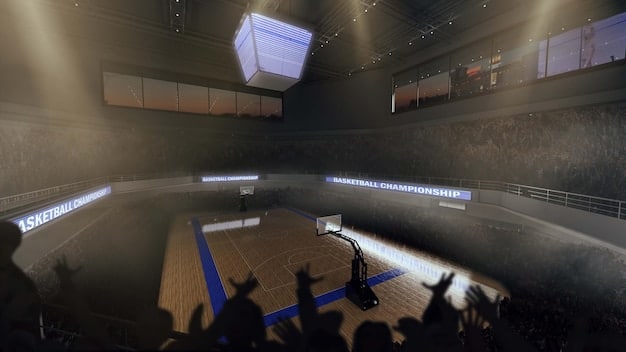College Basketball’s Transfer Portal: Reshaping Rosters in Real Time

The **college basketball’s transfer portal** has drastically altered how teams are built, granting players unprecedented freedom to switch schools and impacting roster construction strategies nationwide.
The landscape of college basketball has undergone a significant transformation, largely due to the emergence and evolution of the **college basketball’s transfer portal**. This portal has become a pivotal tool, reshaping team rosters and altering the dynamics of the sport at every level.
The Genesis of the Transfer Portal
The transfer portal, officially known as the NCAA Transfer Portal, was introduced to streamline the process for college athletes seeking to transfer to different institutions. Previously, athletes often faced restrictions and lengthy waiting periods before being eligible to compete at their new school. The portal aimed to provide a more transparent and efficient system.
The Original Intent
Initially, the transfer portal was designed to offer a centralized database where student-athletes could declare their intention to transfer. This allowed coaches from other schools to view their profiles and initiate contact. The goal was to simplify the process and ensure athletes were aware of their options.
Early Challenges and Criticisms
However, the early days of the transfer portal were not without their challenges. There were concerns about the potential for increased roster turnover, the impact on team chemistry, and the academic implications for student-athletes. Many coaches worried that the portal would destabilize their programs.

Here are some key aspects of the transfer portal’s origins:
- Streamlined Transfer Process: Centralized database for athletes to declare intent to transfer.
- Increased Transparency: Coaches can view profiles and initiate contact easily.
- Initial Concerns: Potential for roster turnover and impact on team chemistry.
- Academic Implications: Ensuring smooth academic transitions for athletes.
Despite the initial challenges, the transfer portal quickly became an integral part of college basketball. Its existence highlighted the growing emphasis on athlete autonomy and the desire for more control over their collegiate careers.
The One-Time Transfer Rule: A Game Changer
One of the most significant developments in the evolution of the transfer portal was the introduction of the one-time transfer rule. This rule allowed undergraduate student-athletes to transfer once without having to sit out a year, a move that fundamentally changed the landscape of college sports.
Immediate Eligibility
The one-time transfer rule granted immediate eligibility to athletes transferring for the first time. This meant players could make an immediate impact on their new teams, which led to a surge in transfer activity across all sports, particularly in college basketball.
Impact on Team Rosters
The immediate eligibility aspect of the rule had a profound impact on team rosters. Coaches now had the ability to quickly fill gaps in their lineups with experienced players from other programs, leading to increased competition for roster spots and more player movement.

Key consequences of the one-time transfer rule include:
- Increased Transfer Activity: Athletes transferring more frequently due to immediate eligibility.
- Enhanced Competition: Coaches using the portal to fill gaps in their rosters.
- Player Empowerment: Athletes having more control over their collegiate careers.
- Dynamic Rosters: Team compositions changing rapidly from year to year.
The one-time transfer rule undeniably reshaped the strategies employed by college basketball programs, requiring coaches to adapt to a new era of roster management and player recruitment.
Strategies for Roster Construction in the Portal Era
In the age of the transfer portal, building and maintaining a competitive roster requires a strategic and adaptable approach. Coaches must now navigate a complex landscape of recruitment, retention, and transfer acquisitions.
Recruiting and Retention
Recruiting high school talent remains a crucial aspect of roster construction. However, coaches must also prioritize player retention by fostering a positive team culture, providing opportunities for player development, and addressing individual needs.
Portal Acquisitions
Actively monitoring the transfer portal is essential for identifying potential additions to the team. Coaches look for players who can fill specific roles, address weaknesses, and bring valuable experience to the program. This often involves a deep dive into player statistics, game film, and background checks.
Balancing Newcomers and Veterans
Successfully integrating transfer players with existing team members is critical for maintaining team chemistry and achieving on-court success. Coaches must strike a balance between welcoming newcomers and valuing the contributions of returning veterans.
Effective strategies for navigating the transfer portal era include:
- Building a Positive Team Culture: Fostering an environment where players feel valued and supported.
- Strategic Portal Monitoring: Identifying players who can fill specific roster needs.
- Skillful Integration: Seamlessly blending transfer players with existing team members.
By adopting these strategies, programs can leverage the transfer portal to enhance their rosters while minimizing potential disruptions to team dynamics.
The Impact on Team Chemistry and Culture
The constant influx of new players through the transfer portal can have a significant impact on team chemistry and culture. Building a cohesive and unified team requires intentional effort and a commitment to shared values.
Building Trust and Relationships
Coaches must actively work to build trust and strong relationships among players, regardless of their backgrounds or how they arrived at the program. This involves open communication, team-building activities, and a focus on shared goals.
Establishing Clear Roles
Clearly defining roles and expectations for each player can help reduce potential conflicts and promote a sense of unity. When players understand their responsibilities and how they contribute to the team’s success, they are more likely to buy into the overall vision.
Addressing Potential Conflicts
Addressing potential conflicts proactively is essential for maintaining a positive team environment. Coaches must be willing to have difficult conversations, mediate disputes, and ensure that all players feel valued and respected.
Key considerations for fostering team chemistry and culture in the transfer portal era:
- Open Communication: Encouraging honest and transparent dialogue among players and coaches.
- Clearly Defined Roles: Ensuring players understand their responsibilities and contributions.
- Conflict Resolution: Addressing potential conflicts proactively and fairly.
While the transfer portal presents challenges to team chemistry, intentional leadership and a focus on shared values can help programs build a strong and cohesive culture.
Player Development in a Transient Environment
In a landscape where players can transfer with relative ease, the approach to player development must adapt. Coaches need to maximize individual potential while recognizing that players may not remain with the program for their entire collegiate careers.
Targeted Skill Enhancement
Focusing on specific skill enhancements can help players improve their game and increase their value, both on and off the court. This may involve individualized training plans, focused drills, and detailed film analysis.
Leadership Development
Investing in leadership development can help players grow as individuals and contribute to the team’s overall success. This may involve workshops, mentoring programs, and opportunities for players to take on leadership roles within the team.
Academic Support
Providing strong academic support is crucial for ensuring that players succeed in the classroom. This may involve tutoring, study skills workshops, and guidance on course selection and time management.
Important aspects of player development in the transfer portal era:
- Personalized Training: Tailoring training plans to individual player needs and goals.
- Leadership Opportunities: Providing opportunities for players to develop leadership skills.
- Comprehensive Support: Offering academic, athletic, and personal support to players.
By prioritizing player development, programs can help athletes reach their full potential, regardless of how long they remain with the team.
The Future of the Transfer Portal
As the transfer portal continues to evolve, several questions remain about its long-term impact on college basketball. Regulatory changes, technological advancements, and shifting player preferences will all play a role in shaping its future.
Potential Regulatory Adjustments
The NCAA may consider further adjustments to the transfer rules in response to ongoing concerns about roster turnover and competitive balance. These adjustments could include restrictions on the timing of transfers, limitations on the number of transfers a team can add each year, or changes to eligibility requirements.
Technological Enhancements
Technological advancements could also play a role in the future of the transfer portal. Enhanced data analytics, virtual reality training tools, and online recruiting platforms could help coaches and players make more informed decisions about transfers.
Evolving Player Preferences
Evolving player preferences will continue to shape the transfer landscape. Factors such as NIL opportunities, coaching styles, academic programs, and geographic location will all influence players’ decisions about where to transfer.
Anticipated developments in the transfer portal landscape include:
- Regulatory Changes: Potential adjustments to transfer rules by the NCAA.
- Technological Advancements: Enhanced tools for data analysis and recruiting.
The transfer portal will likely remain an integral part of college basketball for the foreseeable future, but its specific role and impact will continue to evolve as the sport adapts to changing circumstances.
| Key Point | Brief Description |
|---|---|
| 🔄 Transfer Portal | Centralized database for athletes seeking to transfer. |
| ✅ One-Time Rule | Athletes can transfer once without sitting out a year. |
| 🤝 Team Chemistry | Building a cohesive team with new and veteran players. |
| 🌱 Player Development | Maximizing individual potential in a changing environment. |
Frequently Asked Questions
▼
The NCAA Transfer Portal is a database where student-athletes declare their intention to transfer to another institution. It allows coaches from other schools to view their profiles and initiate contact.
▼
The one-time transfer rule allows undergraduate student-athletes to transfer once without having to sit out a year, granting them immediate eligibility at their new school.
▼
The transfer portal can impact team chemistry by bringing in new players and requiring coaches to build trust and relationships quickly. Clear roles and open communication are crucial.
▼
Coaches focus on recruiting, player retention, and strategic portal acquisitions. Balancing newcomers and veterans while fostering a positive culture is key to success.
▼
Player development adapts to focus on targeted skill enhancement, leadership opportunities, and comprehensive support, helping athletes reach their potential regardless of their tenure.
Conclusion
The **college basketball’s transfer portal** has revolutionized the sport, presenting both challenges and opportunities for coaches and players alike. By understanding the dynamics of the portal and adapting their strategies accordingly, programs can navigate this new landscape and build successful and competitive teams.





